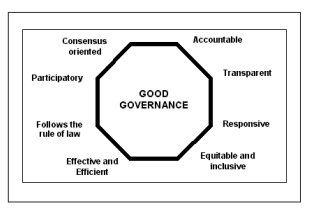- Filter By :
- Theoretical Questions
- Case Studies
-
Q. Putting the citizen first is the guiding principle of good governance. Discuss. (250 words)
06 Feb, 2020 GS Paper 4 Theoretical QuestionsApproach
- Give a brief introduction about Good Governance.
- Discuss how “Citizen first” is the guiding principle of good governance.
- Give a conclusion.
Introduction
Governance is commonly defined as the exercise of power or authority by political leaders for the well-being of their country’s citizens or subjects. Good Governance is the management of public affairs in a just, fair and reasonable manner. Governance is different from good governance on the premise that later focuses on the qualitative aspect of governance.
Body
Citizen-centric governance: the guiding principle of good governance
- Making governance citizen-centric is a fundamental aspect of Good Governance.

- Good governance is understood through its eight indicators or characteristics (1) Participatory; (2) Rule of Law; (3) Effective and Efficient; (4) Transparent; (5) Responsive; (6) Equitable and Inclusive; (7) Consensus Oriented; and (8) Accountability.
- They are inextricably related to each other and targeted to bring citizen-centric governance.
- Good governance involves citizens’ participation in decision making. For example:
- 73rd and 74th Amendment acts brought democratic decentralisation and ensures participation of people at the grassroots level in the governance process.
- Swachh Bharat Mission (SBM) is also a good example where citizens’ participation is given due importance.
- The principle of putting citizens first brings stakeholders, the government and the citizens closer to each other.
- Technology is an important tool for good governance as it ensures transparency and accountability which result in the betterment and welfare of all citizens. It also leads to the simplification of processes. For example,
- the self-certification of startups introduced by the Government exhibits trust in the citizens.
- Digital India ensures that government services are available to the citizen with little human interference.
- Governments’ use of Social media as a tool to connect people is also a citizen-centric good governance practice, where two-way communication is ensured. Citizens register their grievances on social media platforms such as twitter, and government authorities respond to address the same.
- For example, the Ministry of External Affairs (MEA) has been very actively solving problems of NRIs and Indians in abroad based on social media input. Similarly, Railways is actively addressing the concerns of passengers based on social media feedback.
- Other tools that make the governance citizen-centric are Right to information, Citizens’ charters, Grievance redressal mechanisms, public-private partnerships, etc.
Conclusion
Governance can be termed good only if it keeps the citizens first. Such governance model would ensure equitable and inclusive development of society and nation.
To get PDF version, Please click on "Print PDF" button.
Print PDF




